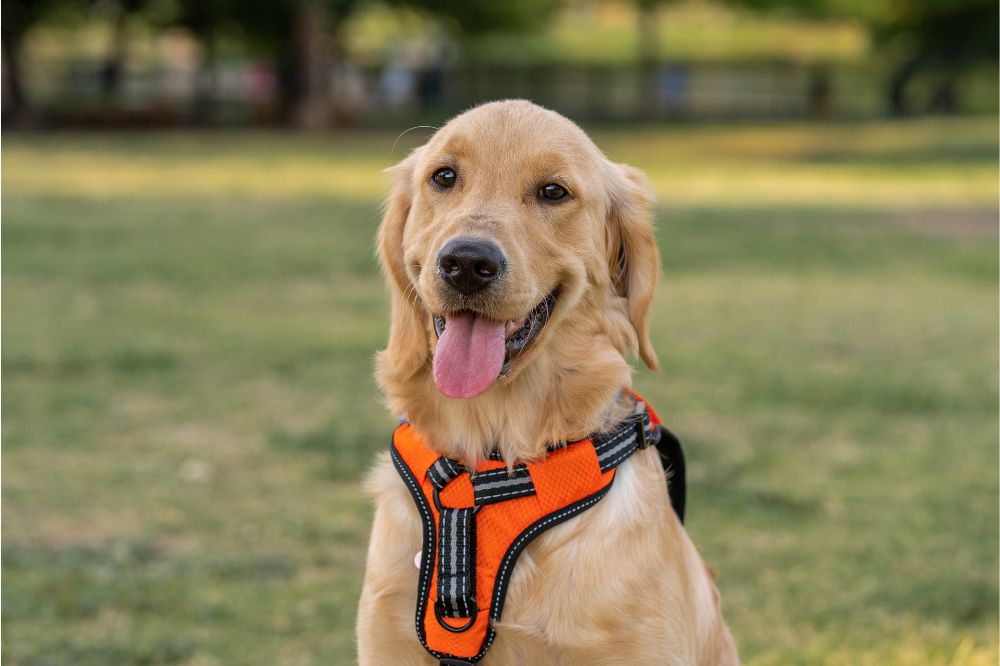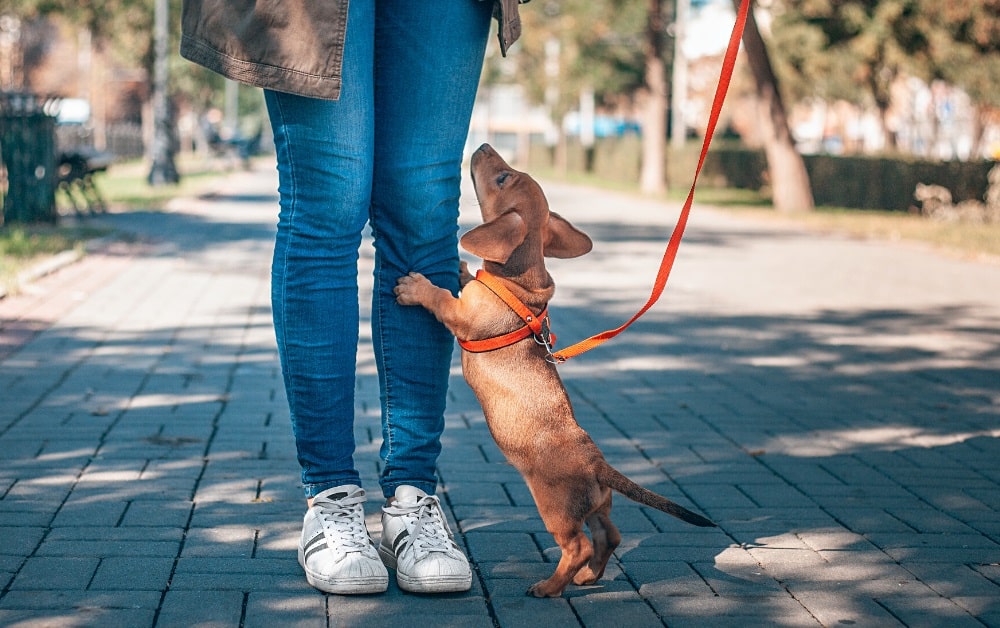When it comes to selecting the best way to keep your dachshund safe, there can be much confusion. I am here to provide clarity on this issue: which is better – a harness or a collar?
For many dog owners, choosing between these two options can seem overwhelming due to their differences. Harnesses offer more control over your pup’s movements while collars are typically easier and faster to put on. But what should you consider when making this important decision? Let me break down the pros and cons of each so that you can confidently make an informed choice for your canine companion.
Finally, as any responsible pet parent knows, safety always comes first. The right style of restraint will help ensure that your beloved dachshund remains healthy and happy during their daily adventures! So let’s get started discussing harnesses versus collars – both have unique advantages and disadvantages depending on your needs.
Description Of A Harness
A harness is a type of pet equipment that fits around the torso and neck of a dog. It’s often made from nylon or leather and comes in various sizes to ensure an ideal fit for your pup. Harnesses are commonly used as an alternative to collars on dogs with tracheal issues due to their less restrictive design; they also provide more control over strong-willed pups who may pull on the leash. Furthermore, when compared to collars, harnesses distribute pressure evenly across the chest which can help reduce strain on sensitive areas like the throat or spine.
When using a harness correctly, it should be snug but not overly tight; if you’re struggling with putting one on your pup, try consulting with a vet behaviorist who will be able to show you how best to use it for optimal results. The benefits of having a properly fitted harness include improved communication between humans and canine companions during walks and better overall safety while out exploring together!
Description Of A Collar
A collar is a piece of equipment that fits around the neck of a dog and can be used for identification, restraint or to show ownership. Generally speaking, collars are much simpler than harnesses in terms of design and function.
When it comes to dogs, there are three main types of collars: flat buckle collars, chain collars and slip collars. Flat buckle collars feature an adjustable strap with a quick-release clip and a ring where owners can attach their pet’s tag; they come in various sizes, colors and patterns, making them ideal for everyday use. Chain collars (also known as choke chains) have several links which allow the user to adjust their size while providing control during training sessions; this type has some drawbacks due to its potential to cause injury if not used correctly. Lastly, slip collars (sometimes referred to as “training” or “check” collars) form loops that slide onto the dog’s head allowing for more precise corrections; these should only be used by experienced handlers who understand proper use.
The following list details some advantages and disadvantages associated with using a collar:
- Advantages: Can be inexpensive compared to other pieces of gear; easy to put on/take off; can quickly identify your pet if lost
- Disadvantages: Not suitable for larger breeds due to risk of slipping off or breaking free from the collar; may cause discomfort depending on fit
- Considerations: Ensure you properly measure your pet before purchasing a collar; look into different styles like the martingale or breakaway designs
Collar selection is important since any ill-fitting item could lead to skin irritation or even tracheal damage in extreme cases – never leave one on too tight! Therefore, consult with your veterinarian prior to purchase so they can provide guidance regarding sizing and style appropriate for your pup’s needs.
Collar vs Harness – Pros And Cons Of Each Option
When considering the best option for your Dachshund, it’s important to weigh the pros and cons of each choice. Harnesses are generally more comfortable than collars when used correctly; this is because harnesses distribute pressure across the chest rather than around the neck. This makes them ideal for dogs that pull while walking as they reduce strain on their necks and trachea. Additionally, harnesses provide better control over difficult-to-manage breeds like Dachshunds since owners can easily attach a leash to both sides of the body.
On the flip side, some people may prefer using a collar instead of a harness due to convenience or aesthetics. Collars also allow you to display identification tags more easily and come in various sizes and materials. However, if improperly fitted, collars can cause chafing injuries or even lead to choking from becoming too tight around the dog’s neck during pulling activities such as running after wildlife or other dogs. Ultimately, choosing between a harness or collar will depend on your individual needs and preferences but be sure that whichever one you pick fits properly and is designed with comfort in mind!
Best Practices For Safety And Comfort
Moving on from the pros and cons of each option, let’s look at some best practices for safety and comfort when it comes to choosing between a dachshund harness or collar.
First off, consider your dog’s size and body type. A well-fitting harness is essential for any breed, but especially so for Dachshunds due to their long backs and short legs. Ensure that you have taken measurements around the chest and neck before purchasing either a harness or collar. If buying online, be sure to check sizing charts carefully!
Next up: think about functionality. Harnesses are great if you plan to use them while walking your dachshund; they distribute pressure more evenly than collars do, preventing injury in case your pup decides to make a sudden dash away from you! However, collars may work better depending on how active your pup is – they can provide just enough control without hindering movement too much when used appropriately.
Finally, pick something stylish! After all, no one wants an ugly harness or collar ruining their pet’s fashion statement. Look out for bright colors with fun patterns – this will help distract your pup during walks as well as add personality to their outfit!
Numeric list of 3 items:
- Consider your dog’s size and body type
- Think about functionality
- Pick something stylish
Frequently Asked Questions
What Kind Of Leash Should Be Used With Either A Harness Or Collar?
When it comes to dogs, there is no one-size-fits-all approach. Each pup is unique and requires a different kind of care tailored to their individual needs. It’s important to consider the type of leash that should be used with either a harness or collar when walking your dog as each provides its own advantages and disadvantages.
Leashes come in many forms, from retractable leashes which allows more freedom for your pet while still keeping them safe, to hands-free leashes which allow you more control over your pup while also allowing you greater flexibility during walks. The choice between using a harness or collar will depend on the breed of dog, size, age and temperament – but what about the type of leash? This can be assessed by considering two key factors: safety and comfort.
When choosing a leash for your pooch, safety should always come first – regardless of the situation. A secure fit ensures that both yourself and your pup are protected against possible harm during outdoor activities. Comfort should also be taken into consideration; making sure any equipment does not cause irritation or discomfort to the animal. Depending on how much control is needed during walks, short leads might be best suited if appropriate training has been undertaken beforehand. Leads made from materials such as leather help keep fur away from buckles too! Ultimately, selecting an appropriate leash will ensure stress free outings with your four-legged friend.
To sum up, finding the right balance between safety and comfort should be a top priority when picking out a suitable lead for your canine companion – whether they’re wearing a harness or collar!
Is It Easier To Train A Dachshund With A Harness Or Collar?
When it comes to training a dachshund, harnesses and collars both have their benefits. So which one is better? That really depends on the individual dog’s needs and preferences.
Harnesses are generally recommended for smaller breeds like Dachshunds as they provide more control than collars. This makes them great tools for discouraging unwanted behaviors such as pulling or lunging when out walking. Harnesses also put less strain on the neck area so can be beneficial if your pup has any respiratory issues or neck pain.
However, some dogs may find the additional restriction of a harness uncomfortable, particularly if they’re quite active and enjoy running around in open areas. Collars may be a better option here since they allow more freedom of movement while still providing enough control over your pup’s behavior during walks. Additionally, you’ll need to make sure that the collar fits correctly – neither too tight nor too loose – so that it doesn’t cause discomfort or irritation to your dog’s neck or throat area.
Ultimately, there isn’t necessarily one right answer; rather it all boils down to taking into account what works best for you and your furry friend! Therefore, take the time to experiment with different types of leashes and see how your pup responds before deciding whether a collar or harness is most suitable for their needs.
How Often Should A Harness Or Collar Be Replaced?
When it comes to choosing between a harness or collar for your dachshund, how often should these accessories be replaced? This is an important question that all pet owners must consider.
I suggest replacing either accessory once every six months. The materials used in collars and harnesses can degrade over time due to wear-and-tear from daily activities as well as exposure to the elements such as sunlight or rain. Additionally, you should take into account any changes in the size of your pup; with growth spurts, their fit may no longer be perfect so don’t forget to check periodically!
It’s vital that both the collar and harness are always snug fitting but not tight. If they become too loose then you may need to replace them sooner than advised. But if the fit remains secure on your dog’s body even after several months, then there’s no problem keeping the same one for longer periods of time – just make sure to monitor it frequently.
Overall, proper care and maintenance is key when taking steps towards ensuring a safe and comfortable experience for your beloved canine companion. Whether opting for a collar or harness, having trusty replacements ready will help ensure this happens more seamlessly over time.
Are There Any Other Options Besides A Harness And Collar For Controlling A Dachshund?
When it comes to controlling a dachshund, many pet owners may think they only have two options: either a harness or a collar. But there are actually other solutions available that could be more effective and even less restrictive for the pup.
First off, let’s start with why collars and harnesses might not always be the best option. Collars can cause issues if your pup pulls too hard on the lead as it can create strain on their neck. A good fit is also crucial in order for them to feel comfortable; an ill-fitting collar can chafe and rub against the fur, causing discomfort. Harnesses come with similar risks – if you don’t buy one of high quality then it won’t last long and may be uncomfortable for your pup to wear over time.
A head halter is another alternative solution which acts like reins around a horse’s head by looping gently but securely around its muzzle area. It gives you control over their movement without straining their necks, while still allowing them some freedom of movement. The same applies to body harnesses which wrap around the lower chest instead of just going round their neck – this provides better balance when walking and ensures no pressure points are created by incorrect sizing or pulling from the handler’s side. Ultimately, both these methods give handlers greater control than traditional collars and harnesses while providing comfort and safety for pups at all times.
It’s important to remember that any type of restraining device should never be used as punishment – rather they should help teach positive reinforcement techniques such as verbal praise or rewards when appropriate behavior is exhibited during walks or training sessions. When done responsibly, certain restraints can prove beneficial in helping you build a strong bond between dog and owner whilst teaching them how to behave appropriately outside of home life environments.
Are There Any Health Benefits To Using A Harness Over A Collar?
When it comes to controlling our canine companions, a harness and collar are commonly used. But are there any health benefits to using one over the other? Let’s take a look at what professional veterinarians recommend.
Benefits of Harnesses:
- Comfort: A well-fitted body harness distributes pressure around your dog’s torso instead of its neck, providing extra comfort for them when out on walks or during activities like agility training.
- Minimizing Injury Risk: Using a harness also helps reduce the risk of injury by giving owners better control in situations where they need to restrain their pets quickly – such as running into busy roads or dangerous areas. This is especially important in breeds with delicate necks and spines, such as dachshunds.
Benefits of Collars:
- Identification Tags: Collars give owners an easy way to attach identification tags and licenses which can help reunite lost pets with their families more easily if needed.
- Training Aid: With the right type of collar, owners can use gentle corrections (such as leash tugging) as part of teaching good behavior without risking pulling too hard on their pet’s neck.
Both collar and harness have advantages depending on what you’re looking for from your pup! It really depends upon individual needs and preferences when deciding which option is best for your furry friend; however, overall most veterinarians agree that a well fitted harness provides both safety and comfort benefits when compared to collars alone.
Conclusion
When it comes to controlling a dachshund, there are several options available. A collar and harness can both be used effectively with the right leash, but deciding which is best for your pup may depend on their individual needs and preferences. Training will likely be easier when using a harness due to its even distribution of pressure around the chest. However, collars offer more flexibility in terms of style and size. It’s important to replace either type of restraint regularly as they tend to wear out quickly.
If neither option appeals to you or your dog, consider looking into alternatives such as head halters or no-pull devices that provide greater control without excessive force on the neck or chest area. Ultimately, you’ll want to choose something comfortable for your pet while providing adequate guidance and safety during walks.
In addition to convenience and comfort, some people opt for a harness instead of a collar because it provides additional health benefits like reducing strain on the airways and shoulders from constant pulling against a collar. Regardless of which one you decide on, always make sure it fits properly so that your dachshund stays safe and secure!









0 Comments